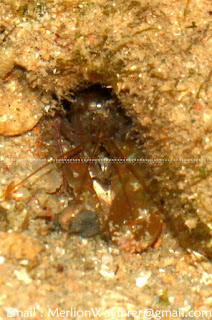Note the little triangular portion on its big claw that appears to be a "fixed back" broken piece? Don't play play, that is the part that snaps shut to cause a loud "Tiak!" sound audible from several metres away. The blast stuns prey like tiny fish and cracks the shells of small clams. It is also used to warn off predators and intimidate rival snapping shrimps.
Merlion Wayfarer spotted two really big ones in a rock pool nearby...
They were of a drab grey colour with one being visibly darker than the other. Were they courting?
A small fish was spotted darting around these burrows. Merlion Wayfarer did wonder if these were friends or food...
Some Snapping Shrimp species share burrows with Goby fishes in a symbiotic relationship. The burrow is built and tended by the Snapping Shrimp, and the Goby provides protection by watching out for danger. When both are out of the burrow, the Shrimp maintains contact with the Goby using its antenna. The Goby, having the better vision, alerts the Shrimp of danger using a characteristic tail movement, and then both retreat into the safety of the shared burrow.
The symbiotic relationship between the Snapping Shrimp and the Goby (Cryptocentrus Leptocephalus, Slender-Lined Shrimp-Goby) is seen here...
A claw is spotted. An unwary observer may think that the poor Goby will soon be the Shrimp's next meal...
When given the go-ahead, the Shrimp slowly comes out of its hiding place...
It heads straight from some debris outside its doorstep, with its antenna in close contact with the Goby...
Effortlessly it moves a twig half its size with its smaller pincer claw...
That out of the way, it retreats back into its burrow.
At the same time, its antenna is still in contact with the Goby...
Sources
- "The association between gobiid fishes and burrowing alpheid shrimps", Oceanography and Marine Biology Annual Review 25: 507–562 by I. Karplus (1987). Retrieved from http://en.wikipedia.org/wiki/Alpheidae#cite_note-8.
- "Snapping shrimps" (December 2008). Wild Fact Sheets, Wild Singapore. Retrieved from http://www.wildsingapore.com/wildfacts/crustacea/othercrust/shrimp/alpheidae.htm.
- "Alpheidae" (23 January 2013). Wikipedia. Retrieved from http://en.wikipedia.org/wiki/Alpheidae.
















































